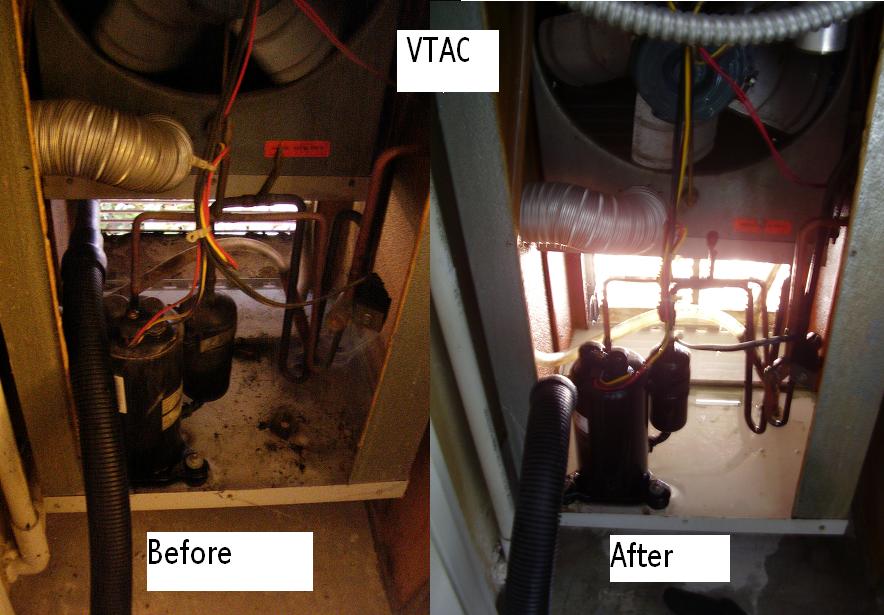Providing PTAC Cleaning Services With Premium Options

IN-ROOM PTAC CLEANING
Keeping PTAC Units clean is crucial to their operation, and Industry studies have shown that regular deep cleaning can offer significant financial savings. By cleaning them properly, operators can extend the life of their units and ensure they are in peak condition during use.
KELLEY’S IN-ROOM PTAC CLEANING
DELUXE IN-ROOM PTAC CLEANING
- Testing – Units are tested before and after cleaning and the control board area is covered for protection.
- Complete coil cleaning - Coils are cleaned with 180-200 ̊ F water and environmentally safe, non-acidic cleaner, as recommended by leading manufacturers.
- Condensate pan - Dirt and organic matter are thoroughly removed from the condensate pan and other critical areas.
- Drain line - The condensate drain is flushed out with pressurized water to prevent clogging and overflow.
- Disinfection – A hospital-grade disinfectant is used in conjunction with 180-200 ̊ F water.
- Filters – Filters are cleaned and sanitized to maximize airflow and prevent re-contamination.
- Sleeve - Dirt and debris are removed from the PTAC sleeve.


PREMIUM OPTIONS
Recommended for properties in high humidity areas, have smoking rooms, malodors, or other air quality concerns.
- The PTAC cover is vacuumed to remove accumulated lint.
- The entire unit is treated with Simple Green d Pro3. This hospital-grade product contains a high level of active ingredients effective against serious public health concerns, including E-coli, HIV-1, Influenza, MRSA, Salmonella, Staphylococcus, Streptococcus, Athlete’s Foot Fungus, and more.
For a minimum amount, both packages include the addition of screws and sleeve clips to equal four.
HVAC SPLIT SYSTEM CLEANING
An HVAC split system is a combination of an indoor air-handling unit that contains the evaporator coil and a matching outdoor condensing unit. The indoor system is connected to the remote condenser, usually located on the ground or roof, using refrigerant piping (hence the name "split").
MINI-SPLITS
Mini-split Systems have two main components: An indoor air-handling unit and an outdoor compressor/condenser. A conduit, which houses the power cable, refrigerant tubing, suction tubing, and condensate drain, links the outdoor and indoor units.
The indoor air-handling unit houses the condenser coil in addition to rotary blades hidden in the outlet of the airflow (below left-contaminated rotary blades). Depend on Kelley to thoroughly clean each of these critical components.
Along with regular maintenance of your indoor air-handling unit, the outdoor condenser should be inspected and cleaned at least once per year as, over time, dirt, pollen, leaves, and debris will impede airflow.
VTAC (VERTICAL) PTAC CLEANING
VTAC units are generally manufactured in one or two configurations.
- The units resemble a cube. The evaporator and condenser coils sit back to back, as with most vtaGE and Friedrich units.
Cleaning companies will often clean the room-side evaporator coil, leaving the critical condensing coil dirty, as the only way to access it, is to remove the unit from the chassis. This is a recipe for failure. Kelley’s has a process for cleaning these units outdoors, accessing both coils in addition to other critical components. - The units resemble an upright rectangle. The two coils are offset, upper and lower, as in the case of most Amana and First Co. units.
Kelley’s uses an in-room cleaning process, which has been approved by First Company, a leading manufacturer of VTAC units
FAN COIL UNIT CLEANING
Fan-Coil Units are available in horizontal, vertical, and console configurations; exposed and concealed cabinets. They are part of an overall system that consists of multiple fan coil units, a piping system, a chiller, and a boiler. Fan coil units are generally comprised of a coil/s, condensate pan, one or more fan motors, a filter, and a cabinet to house these components.
Frequent filter replacement is your first line of defense, followed by regular cleaning of the coil/s and condensate pan and ensuring proper drainage. This will reduce the likelihood of contaminants reaching the fan motor assemblies and ensure your units deliver the results you need.
WATER SOURCE HEAT PUMPS
A water source heat pump is a self-contained water-cooled heating and cooling unit with a reversible refrigerant cycle. Available in horizontal, vertical, and console configurations, the components are typically enclosed in a casing and include a heat exchanger, a heating/cooling coil, a compressor, a fan, a reversing valve, and controls.
Frequent filter replacement is your first line of defense, followed by regular cleaning of the coil and condensate pan and ensuring proper drainage.
AHU – AIR HANDLING UNIT/MAU

MAKE-UP AIR UNIT CLEANING
Air handling units (AHUs) are used to supply and circulate air around a building. Essentially, an AHU is an encased system containing a fan, heating/cooling coils, filters, humidifiers, sound attenuators, and dampers.
An air handler that conditions 100% outside air, and no re-circulated air, is a makeup air unit (MAU). Make-up air systems replace stale air exhausted from buildings with fresh, heated outdoor air, usually maintained at the same temperature as the desired comfort level for the building's heating system.
Although bank filters are used, over time, dirt, pollen, leaves, and debris will impede airflow. To perform effectively and efficiently, coils should be cleaned regularly.
PACKAGED RTUS ROOFTOP UNITS
The term “packaged” refers to factory-made assemblies that normally include an evaporator or cooling coil, evaporator fan, compressor, and condenser combination. (may also include a heating function) integrated into one cabinet. Since these units are most often placed on the roof, single package units are commonly called “rooftop” units (RTUs). They come in various configurations based on their particular application.
Although well equipped to handle the effects of the weather, over time, dirt, pollen, leaves, and debris will impede airflow. They require frequent filter replacement and regular coil cleaning to perform effectively and efficiently.